This document summarizes an article that proposes using color histogram processing to improve the efficiency of content-based image retrieval (CBIR) systems. It describes computing feature vectors for global descriptor attributes to characterize images prior to calculating color histograms, in order to reduce computation time and make the CBIR system more efficient. The performance of using global descriptor attributes and color histograms for image retrieval is evaluated and results are presented. While this approach shows some improved performance over prior methods, the authors conclude that further modifications are still needed to optimize image search capabilities.
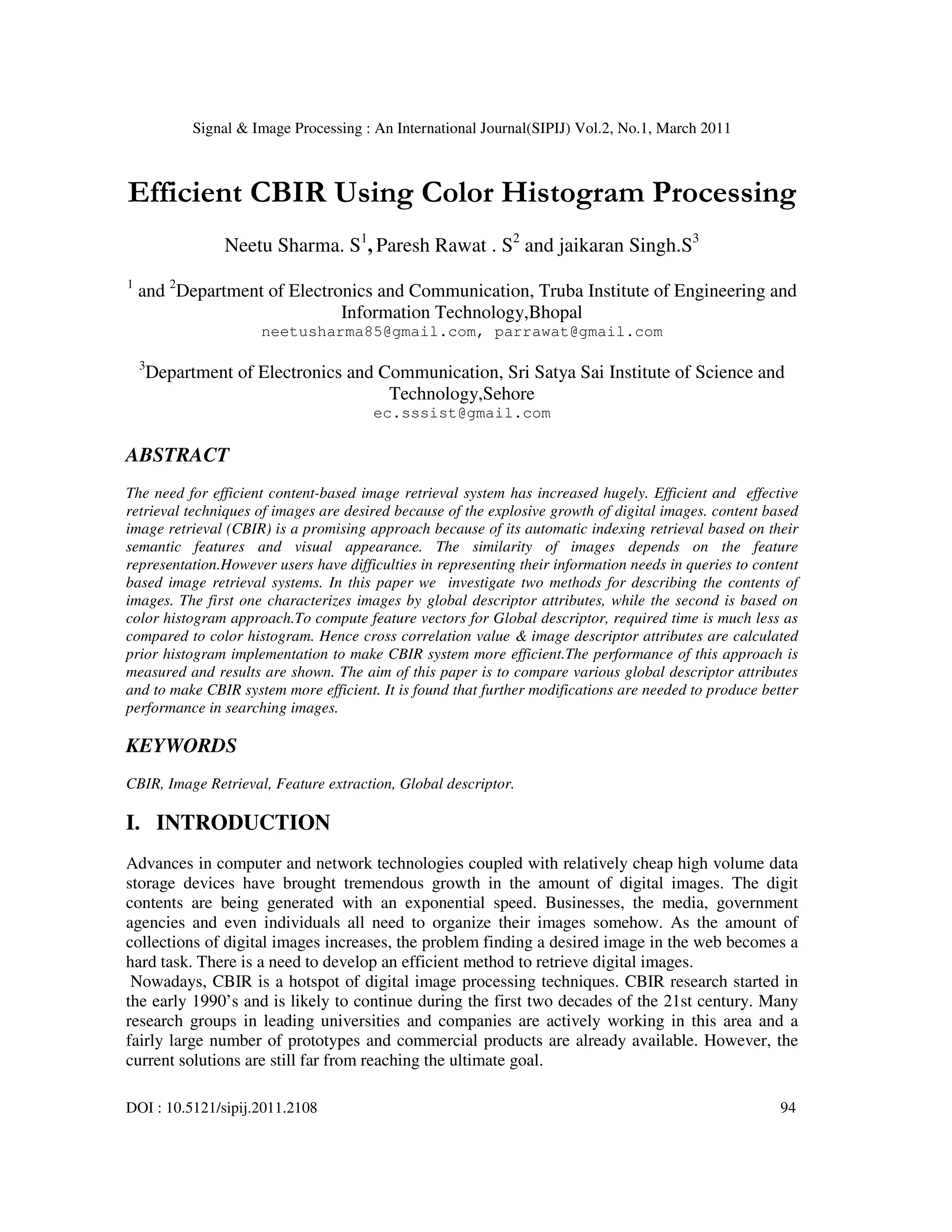
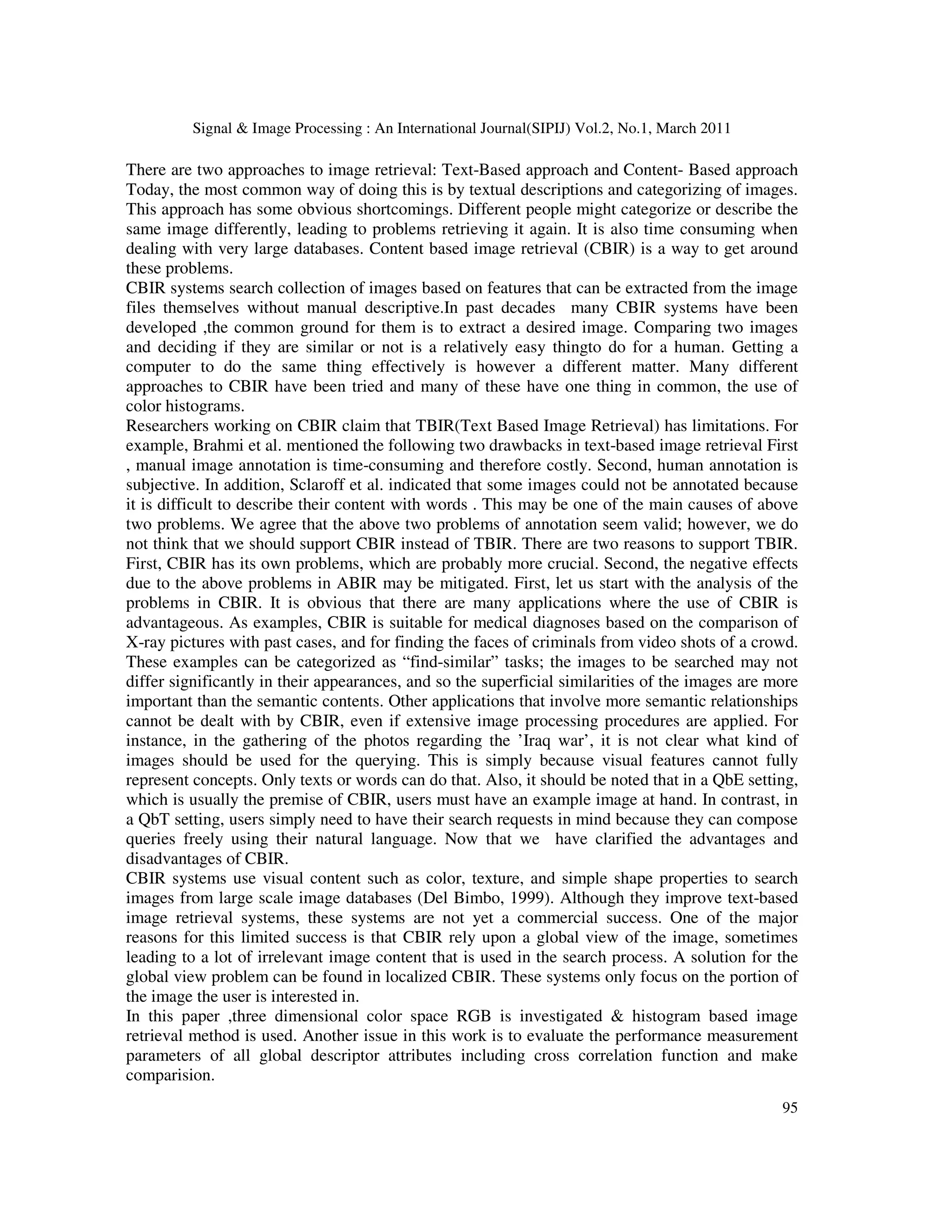
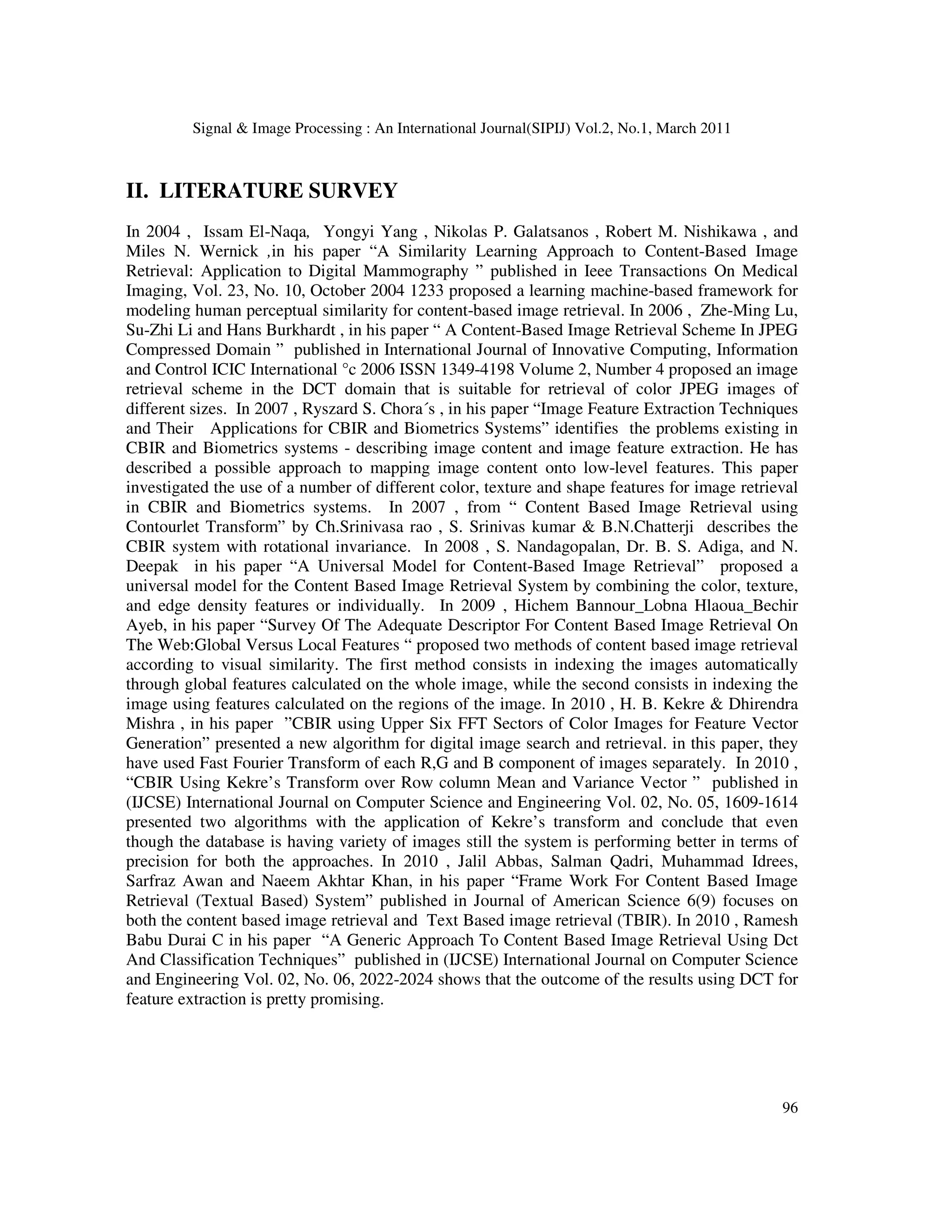
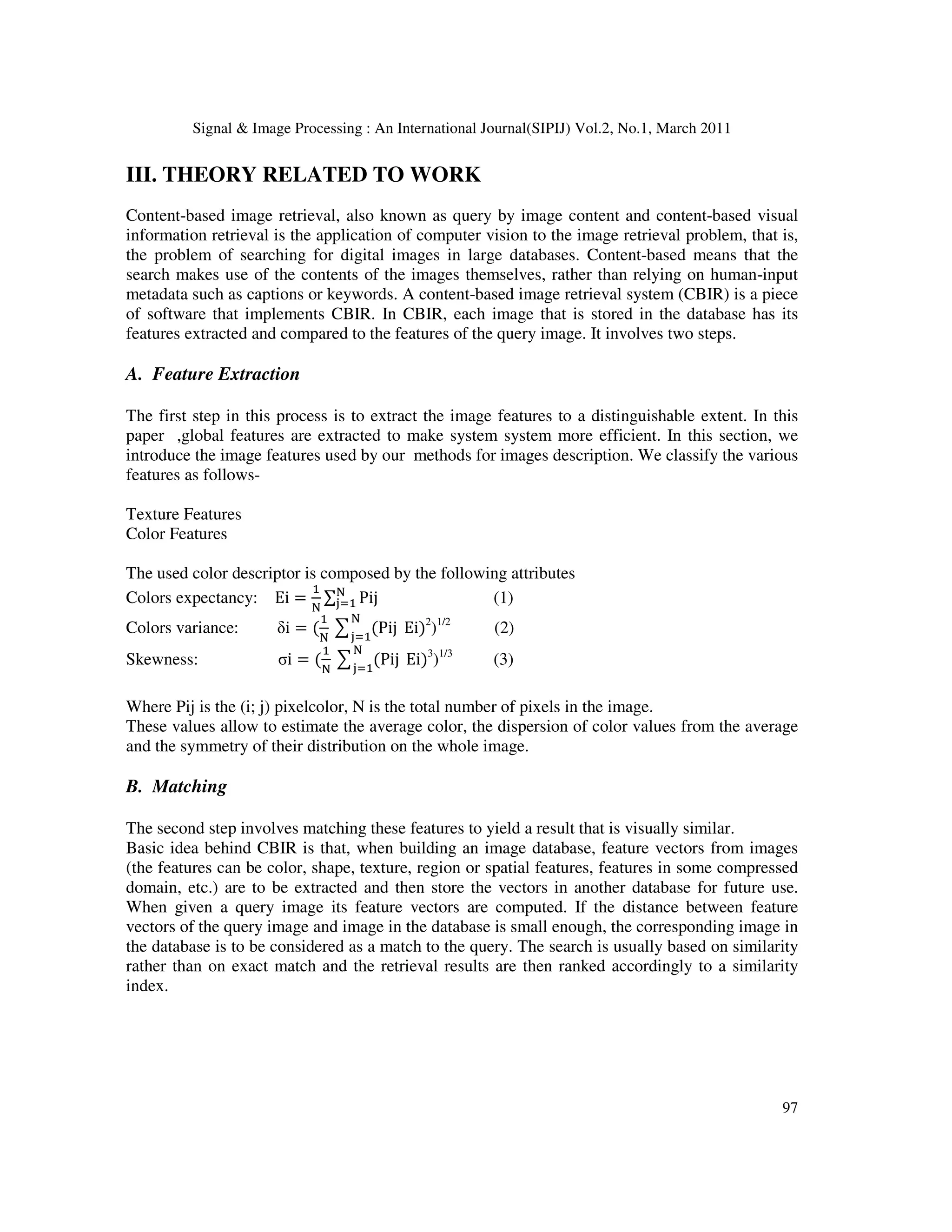
![Signal Image Processing : An International Journal(SIPIJ) Vol.2, No.1, March 2011 98 Figure 1: Block diagram of CBIR system IV. COLOR SPACE A color space is defined as a model for representing color in terms of intensity values.Typically,a color space defines a one-to-four dimensional space.A color component or a color channel is one of the dimensions. A color dimensional space(i.e. one dimension per pixel) represents the gray scale space. A. The RGB colour model The RGB model uses three primary colors, red, green and blue, in an additive fashion to be able to reproduce other colors. As this is the basis of most computer displays today, this model has the advantage of being easy to extract. In a true-color image each pixel will have has a red, green and blue value ranging from 0 to 255 giving a total of 16777216 different colors. Figure 2: Additive mixing of red, green and blue[6]](https://image.slidesharecdn.com/2111sipij08-230628105339-bca98ad8/75/Efficient-CBIR-Using-Color-Histogram-Processing-5-2048.jpg)
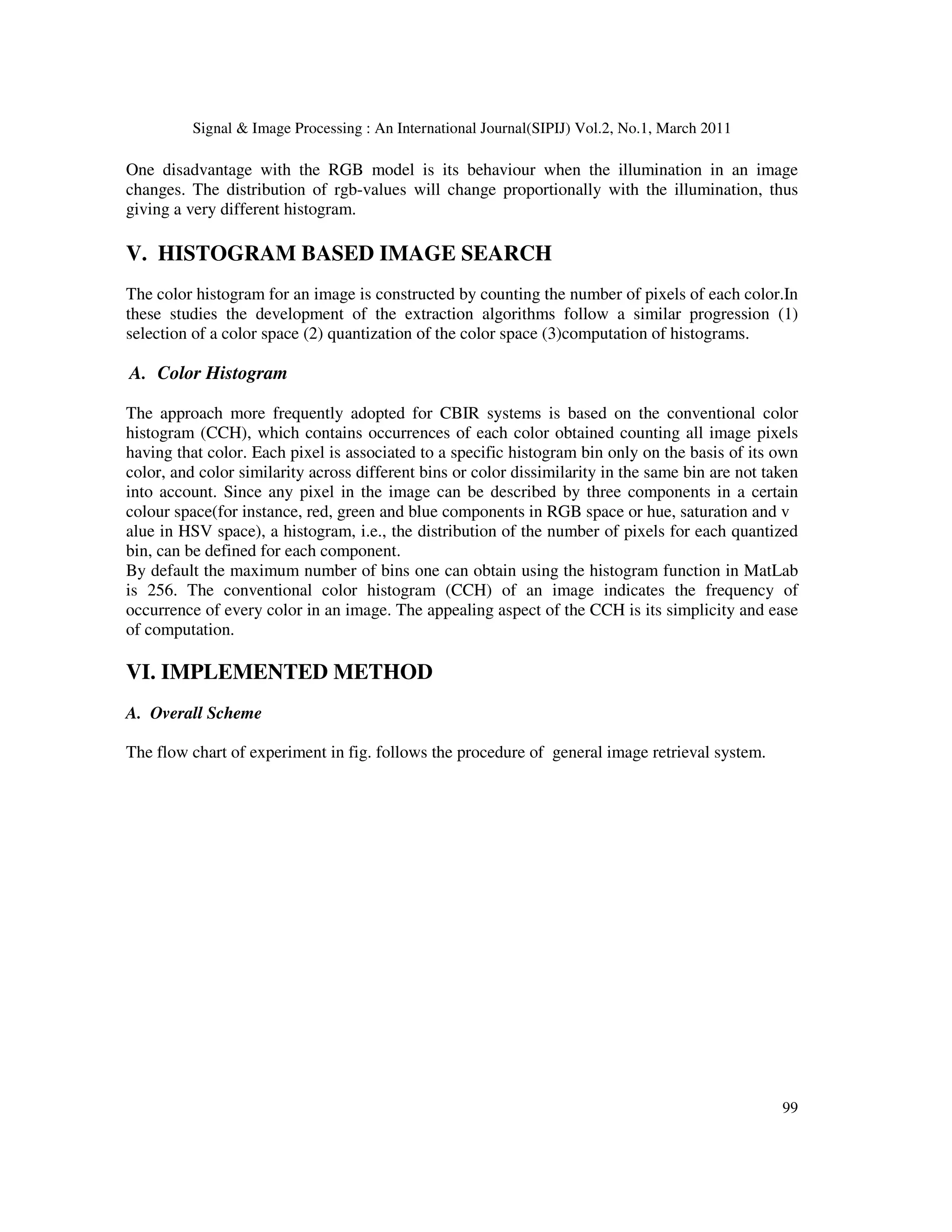
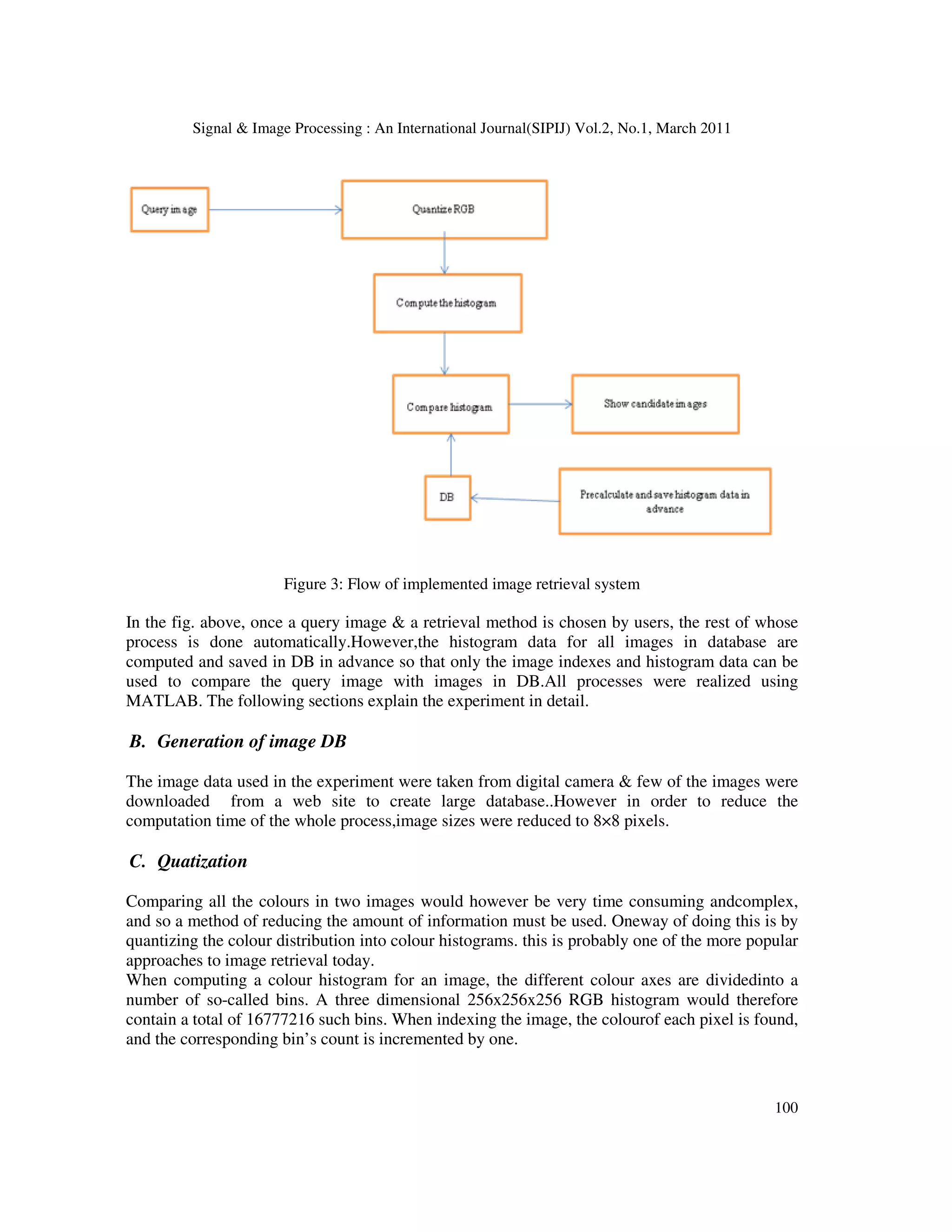
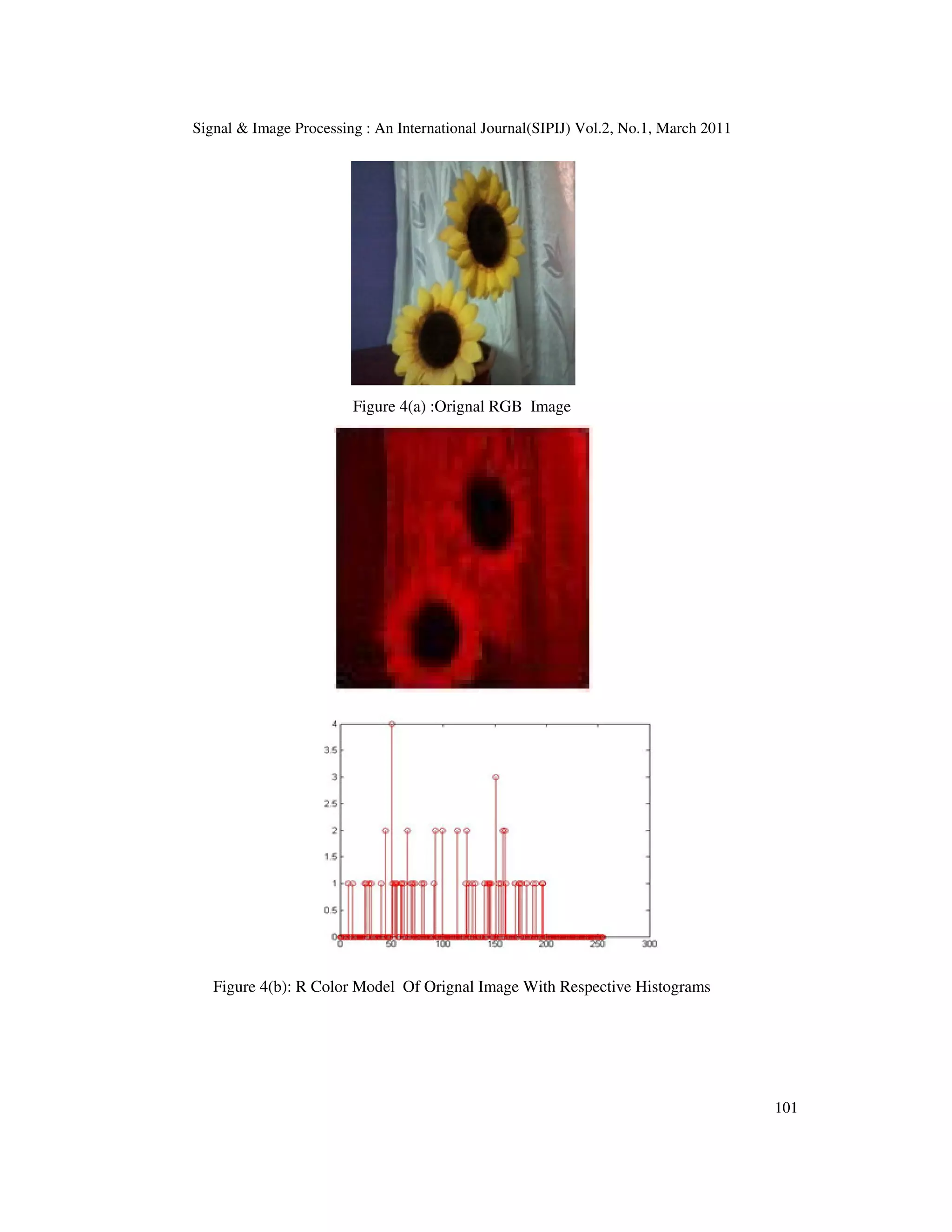
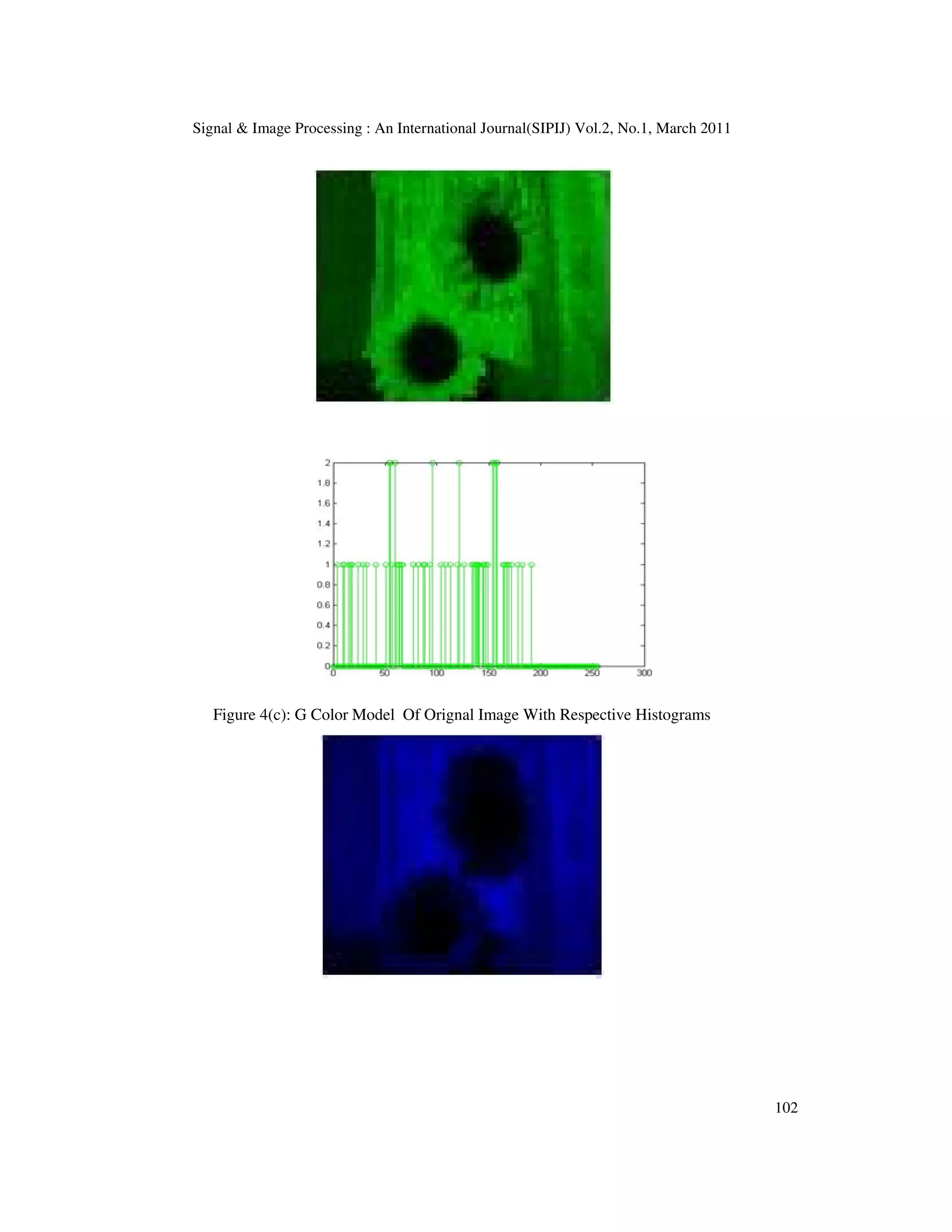
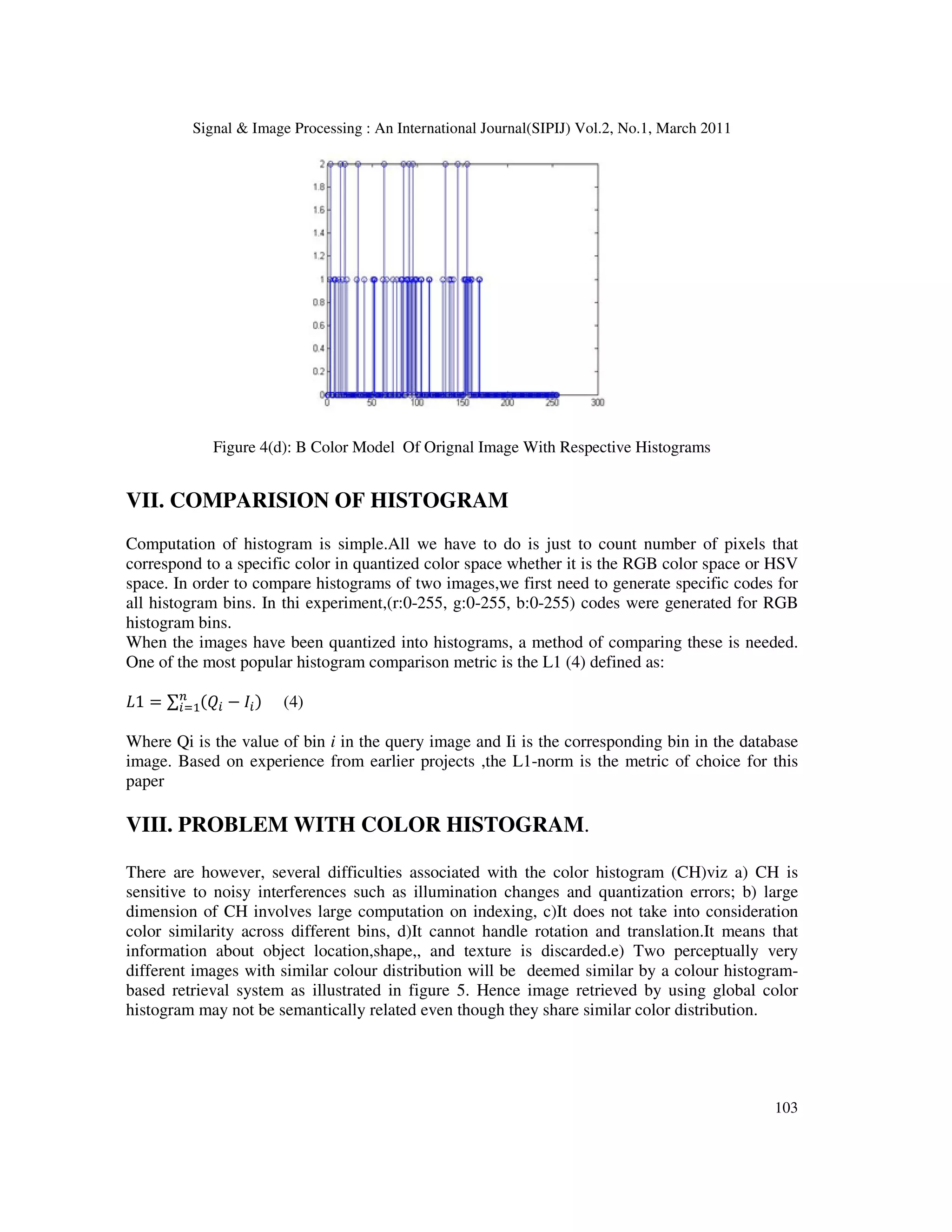
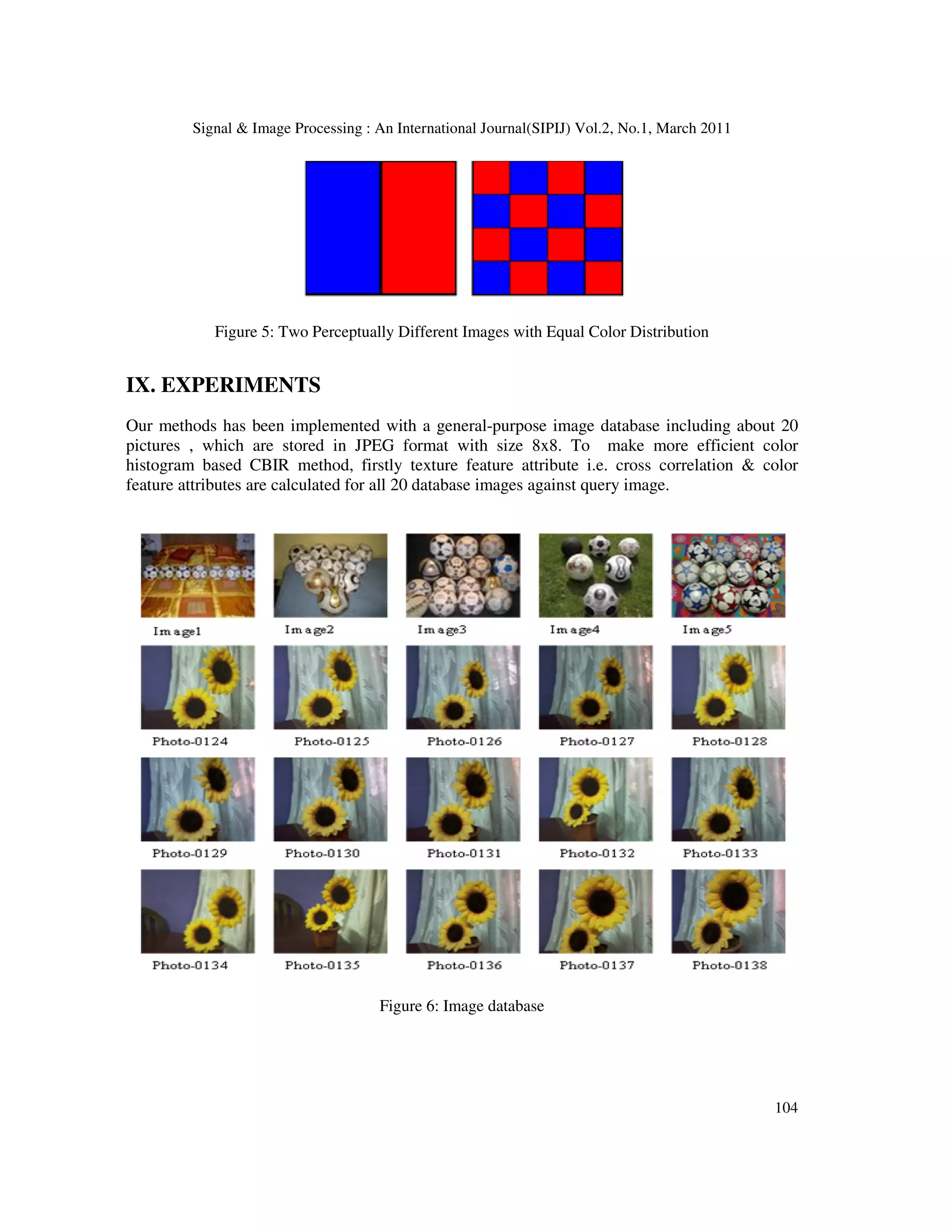
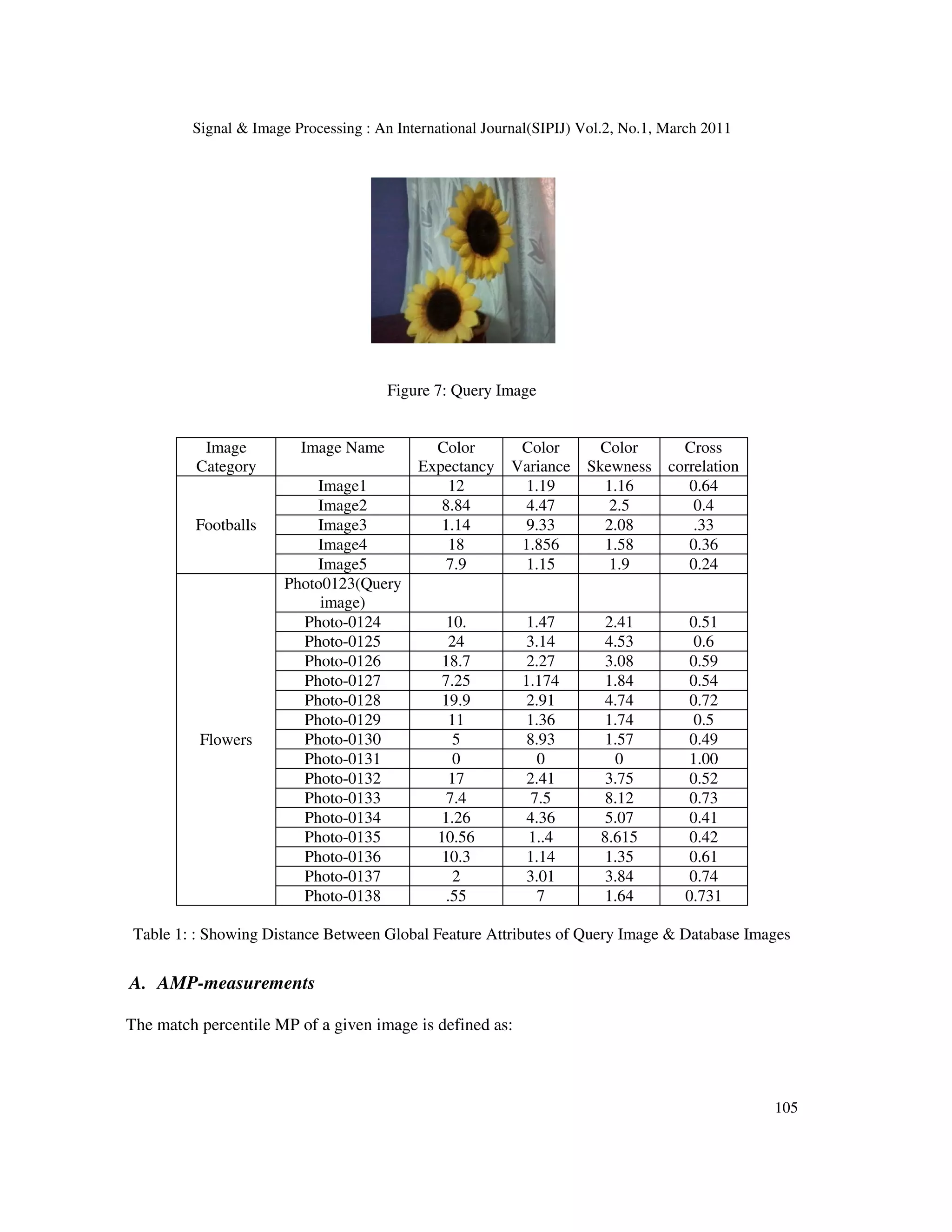
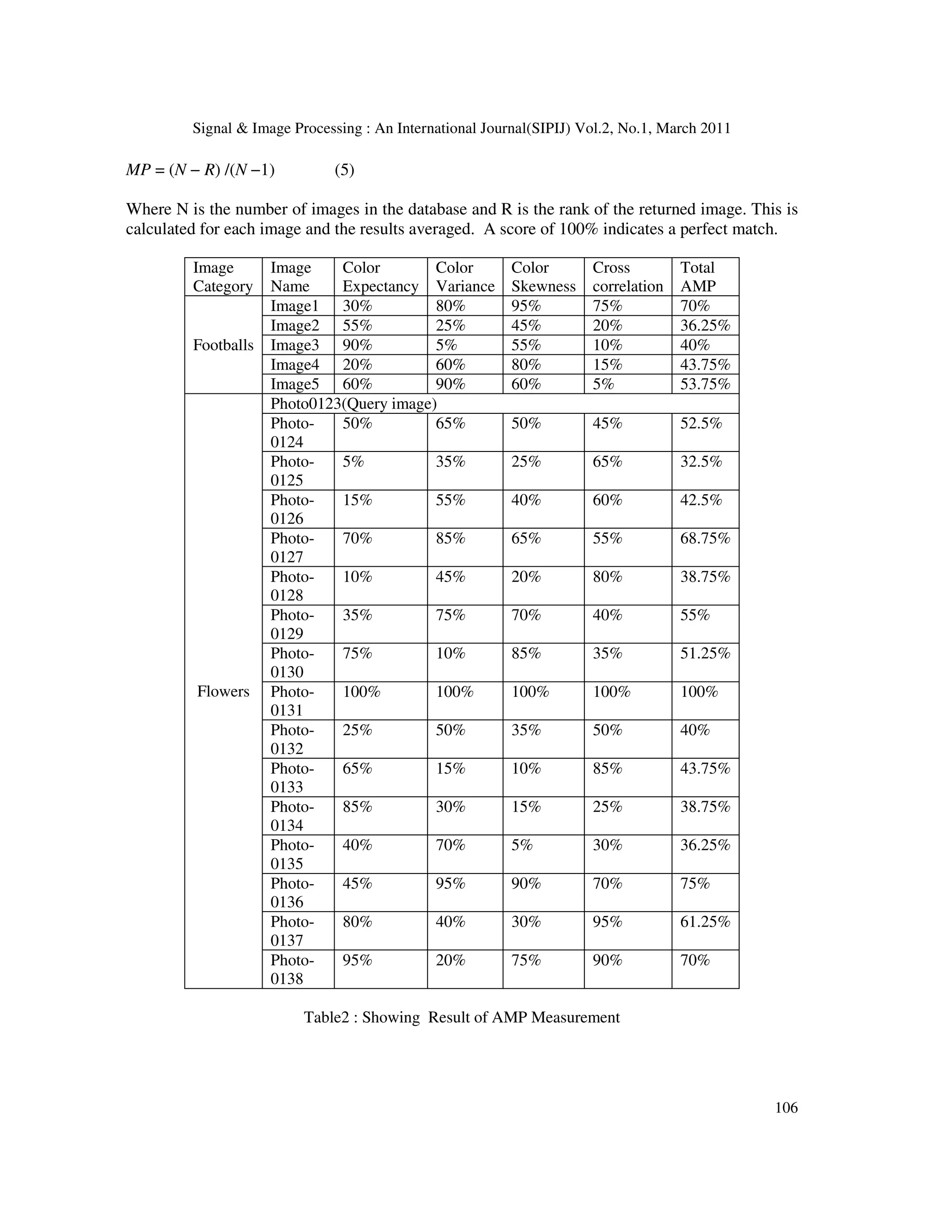
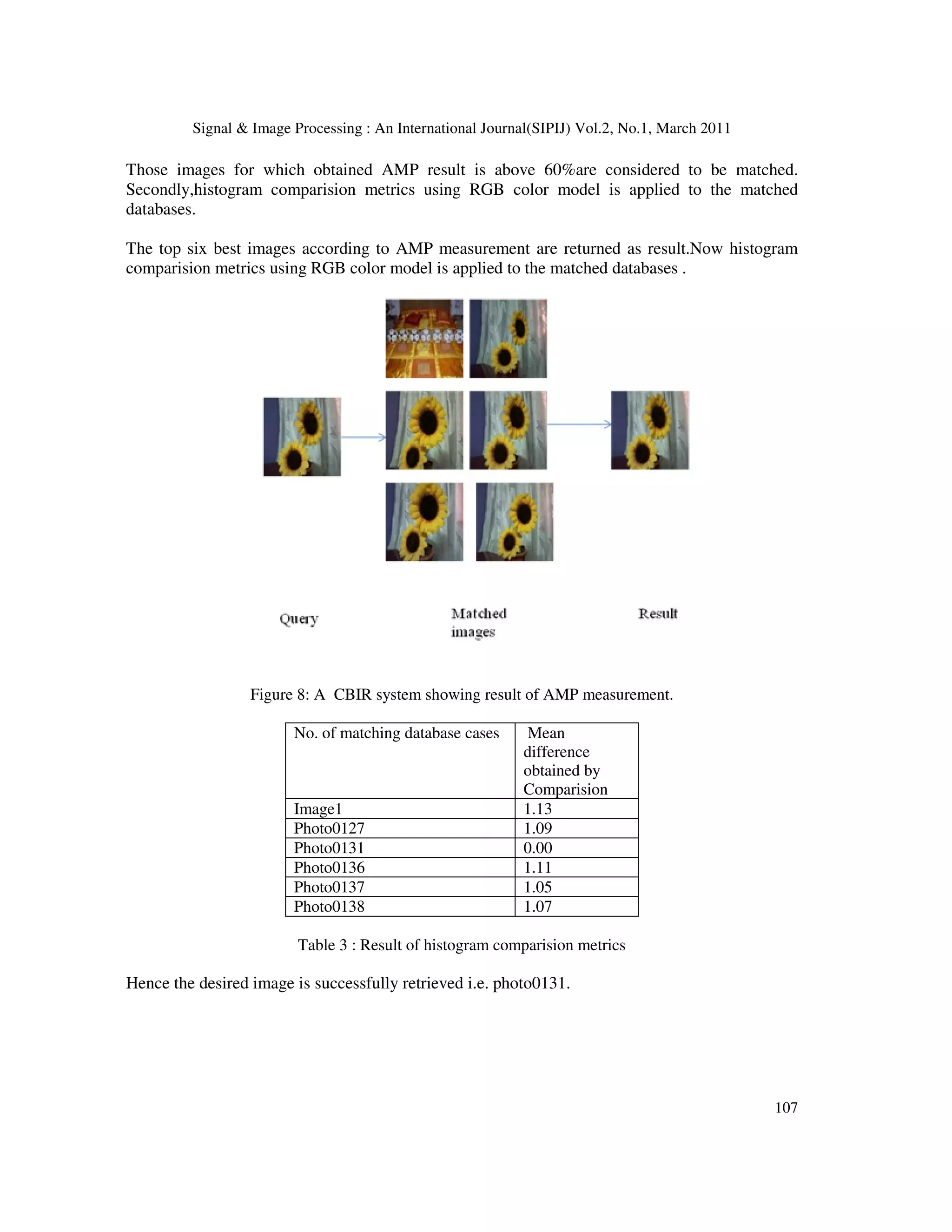
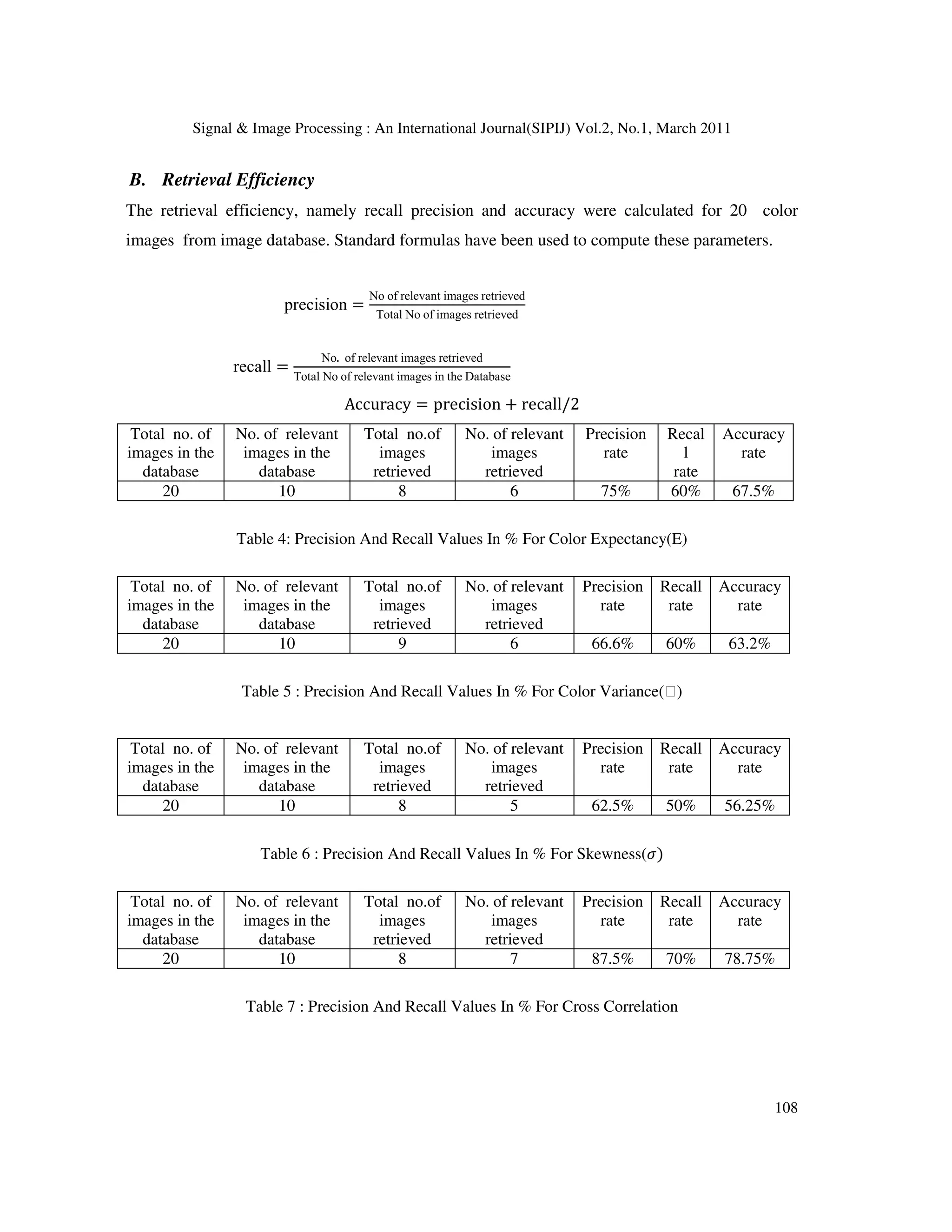
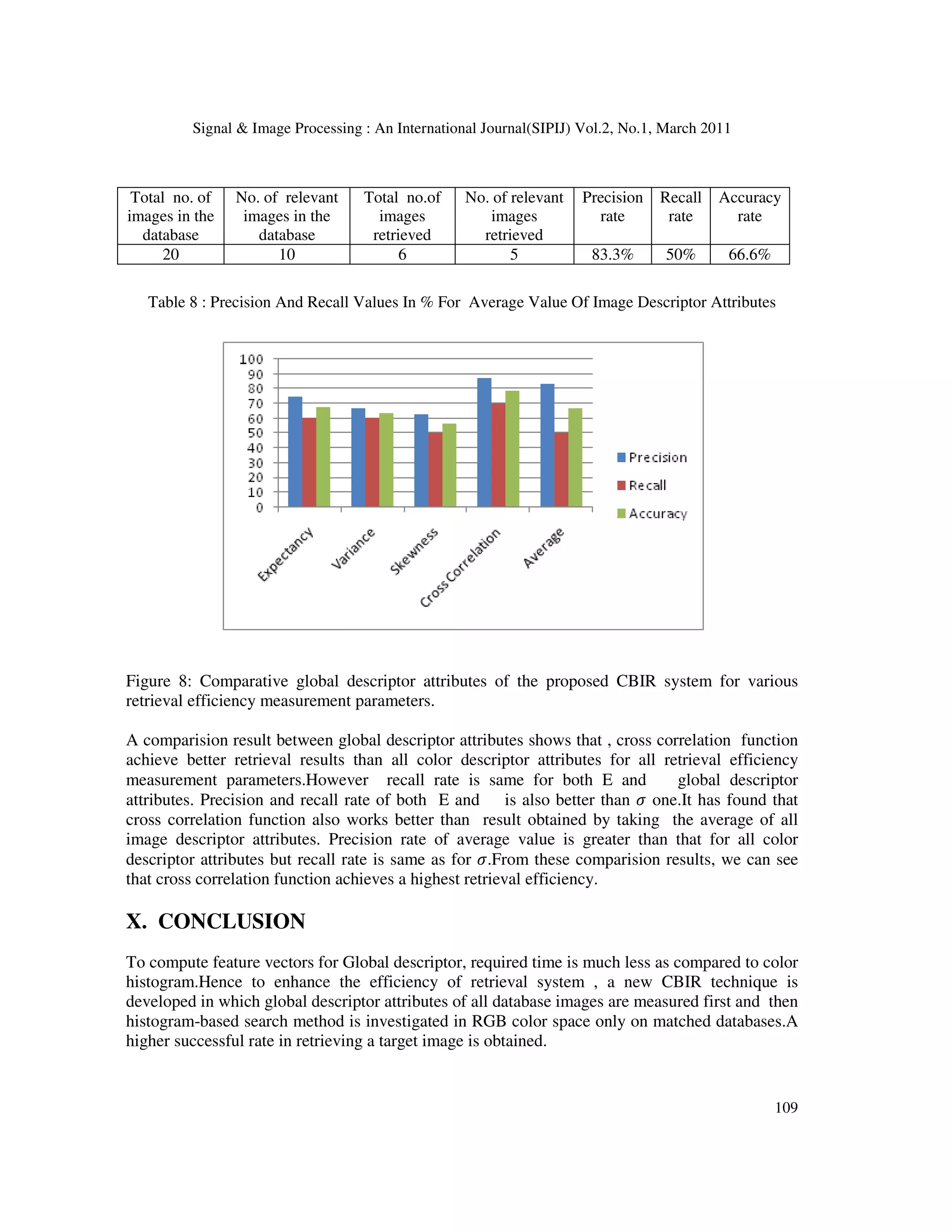
![Signal Image Processing : An International Journal(SIPIJ) Vol.2, No.1, March 2011 110 The performance of various image feature attributes are measured and compared. A comparision result between global descriptor attributes containing texture feature attribute “cross correlation” and color feature attributes “ color expectancy, color variance, skewness” shows that cross correlation function achieves better retrieval results than all color descriptor attributes for all retrieval efficiency measurement parameters. Histogram search characterizes an image by its color distribution, or histogram but the drawback of a global histogram representation is that information about object location, shape, and texture is discarded. Thus this paper showed that images retrieved by using the global color histogram may not be semantically related even though they share similar color distribution in some results.This drawback is also minimized upto some limit by calculating color feature attributes along with efficient implementation. XI. FUTURE SCOPE On the approaches proposed in this paper, further work and testing is needed for them to be effective.For future work, Finding good parameters could be another subject to improve histogram-based search algorithm. There are several difficulties associated with the color histogram (CH) as mentioned above. To address the problem of rotation and translation an invariant color histograms based on the color gradients can be used makes which use of gradients in different channels that weight the influence of a pixel on the histogram to cancel out the changes induced by deformations.To address the problem of spatial relationship and large variations between neighboring bins of conventional color histograms ,fuzzy color histogram (FCH) can be used, by considering the color similarity of each pixel’s color associated to all the histogram bins through fuzzy-set membership function. In comparison with the conventional color histogram (CCH), which assigns each pixel into one of the bins only, FCH spreads each pixel’s total membership value to all the histogram bins. Another area in the field of CBIR where more work is needed is creating consumer applications that use the technology already available. XII. REFERENCES [1] Shengjiu Wang, “A Robust CBIR Approach Using Local Color Histograms,” Technical Report TR 01- 03, Departement of computing science, University of Alberta, Canada. October 2001. [2] R. Schettini, G. Ciocca, S Zuffi. A survey of methods for colour image indexing and retrieval in image databases. Color Imaging Science: Exploiting Digital Media, (R. Luo, L. MacDonald eds.), J. Wiley, 2001. [3] R. Russel, P Sinha. Perceptually based Comparison of Image Similarity Metrics.,MIT AI Memo 2001- 014. Massachusetts Institute of Technology, 2001 [4] J.F. Omhover, M. Detyniecki and B. Bouchon-Meunier, “A Region Similarity Based Image Retrieval System”, The 10th International conference on Information Processing and Management of Uncertainty in Knowledge-Based Systems Perugia,Italy 2004. [5] http://en.wikipedia.org/wiki/RGB,](https://image.slidesharecdn.com/2111sipij08-230628105339-bca98ad8/75/Efficient-CBIR-Using-Color-Histogram-Processing-17-2048.jpg)
![Signal Image Processing : An International Journal(SIPIJ) Vol.2, No.1, March 2011 111 [6] OleAndreasFlaatonJonsgard, Improvements on color histogram based CBIR,2005. [7] http://en.wikipedia.org/wiki/HSV_color_space, [8] Ryszard S. Chora´s”Image Feature Extraction Techniques and Their Applications for CBIR and Biometrics Systems” international journal of biology and biomedical engineering,2007. [9] H. B. Kekre , Dhirendra Mishra “CBIR using Upper Six FFT Sectors of Color Images for Feature Vector Generation” H.B.Kekre. et al /International Journal of Engineering and Technology Vol.2(2), 2010, 49-54. [10]Ch.Srinivasa rao , S. Srinivas kumar #, B.N.Chatterji “ Content Based Image Retrieval using Contourlet Transform” ICGST-GVIP Journal, Volume 7, Issue 3, November 2007. [11]Dr. H. B. Kekre Kavita Sonavane “CBIR Using Kekre’s Transform over Row column Mean and Variance Vector ” (IJCSE) International Journal on Computer Science and Engineering Vol. 02, No. 05, 2010, 1609-1614. [12]S. Nandagopalan, Dr. B. S. Adiga, and N. Deepak “A Universal Model for Content-Based Image Retrieval” World Academy of Science, Engineering and Technology 46 2008. [13]P. B. Thawari N. J. Janwe “CBIR Based On Color And Texture” International Journal of Information Technology and Knowledge Management January-June 2011, Volume 4, No. 1, pp. 129-132. [14]Jalil Abbas, Salman Qadri, Muhammad Idrees3, Sarfraz Awan, Naeem Akhtar Khan1 “Frame Work For Content Based Image Retrieval (Textual Based) System” Journal of American Science 2010;6(9). [15]Ramesh Babu Durai C “A Generic Approach To Content Based Image Retrieval Using Dct And Classification Techniques” (IJCSE) International Journal on Computer Science and Engineering Vol. 02, No. 06, 2010, 2022-2024. [16]Ch.Srinivasa Rao , S.Srinivas Kumar and B.Chandra Mohan “ CBIR Using Exact Legendre Moments And Support Vector Machine” International Journal Of Multimedia And Its Applications Vol.2,No.2,May 2010. [17]Hichem Bannour_Lobna Hlaoua_Bechir Ayeb, “Survey Of The Adequate Descriptor For Content Based Image Retrieval On The Web:Global Versus Local Features “ 2009. [18]Hiremath P.S. and Jagadeesh Pujari “Content Based Image Retrieval using Color Boosted Salient Points and Shape features of an image” International Journal of Image Processing, Volume (2) : Issue (1). [19]Zhe-Ming Lu, Su-Zhi Li and Hans Burkhardt , “ A Content-Based Image Retrieval Scheme In JPEG Compressed Domain ” International Journal of Innovative Computing, Information and Control ICIC International °c 2006 ISSN 1349-4198 Volume 2, Number 4, August 2006. [20]Issam El-Naqa, Yongyi Yang , Nikolas P. Galatsanos , Robert M. Nishikawa , and Miles N. Wernick , “A Similarity Learning Approach to Content-Based Image Retrieval: Application to Digital Mammography ” Ieee Transactions On Medical Imaging, Vol. 23, No. 10, October 2004 1233.](https://image.slidesharecdn.com/2111sipij08-230628105339-bca98ad8/75/Efficient-CBIR-Using-Color-Histogram-Processing-18-2048.jpg)
![Signal Image Processing : An International Journal(SIPIJ) Vol.2, No.1, March 2011 112 [21]Joel Ponianto , “Content-Based Image Retrieval Indexing” School of Computer Science and Software Engineering Monash University, 2005. [22]Sameer Antani, L. Rodney Long, George R. Thoma , “Content-Based Image Retrieval for Large Biomedical Image Archives ” MEDINFO 2004 M. Fieschi et al. (Eds) Amsterdam: IOS Press © 2004 IMIA. [23]Stefan Uhlmann, Serkan Kiranyaz and Moncef Gabbouj, “A Regionalized Content-Based Image Retrieval Framework” 15th European Signal Processing Conference (EUSIPCO 2007), Poznan, Poland, September 3-7, 2007, copyright by EURASIP. [24]Ricardo da S. Torres, Alexandre X. Falco , “A New Framework to Combine Descriptors for Content based Image Retrieval ” IKM’05, October 31.November 5, 2005, Bremen, Germany. Zhong Su, Hongjiang Zhang, Stan Li, and Shaoping Ma , “Relevance Feedback in Content-Based Image Retrieval: Bayesian Framework, Feature Subspaces, and Progressive Learning” IEEE Transactions On Image Processing, Vol. 12, No. 8, August 2003. Authors [1] Neetu Sharma is pursuing her Post Graduation(MTECH) in VLSI Design, Her Area of interest include Image Processing, Multimedia and VLSI Technology.](https://image.slidesharecdn.com/2111sipij08-230628105339-bca98ad8/75/Efficient-CBIR-Using-Color-Histogram-Processing-19-2048.jpg)